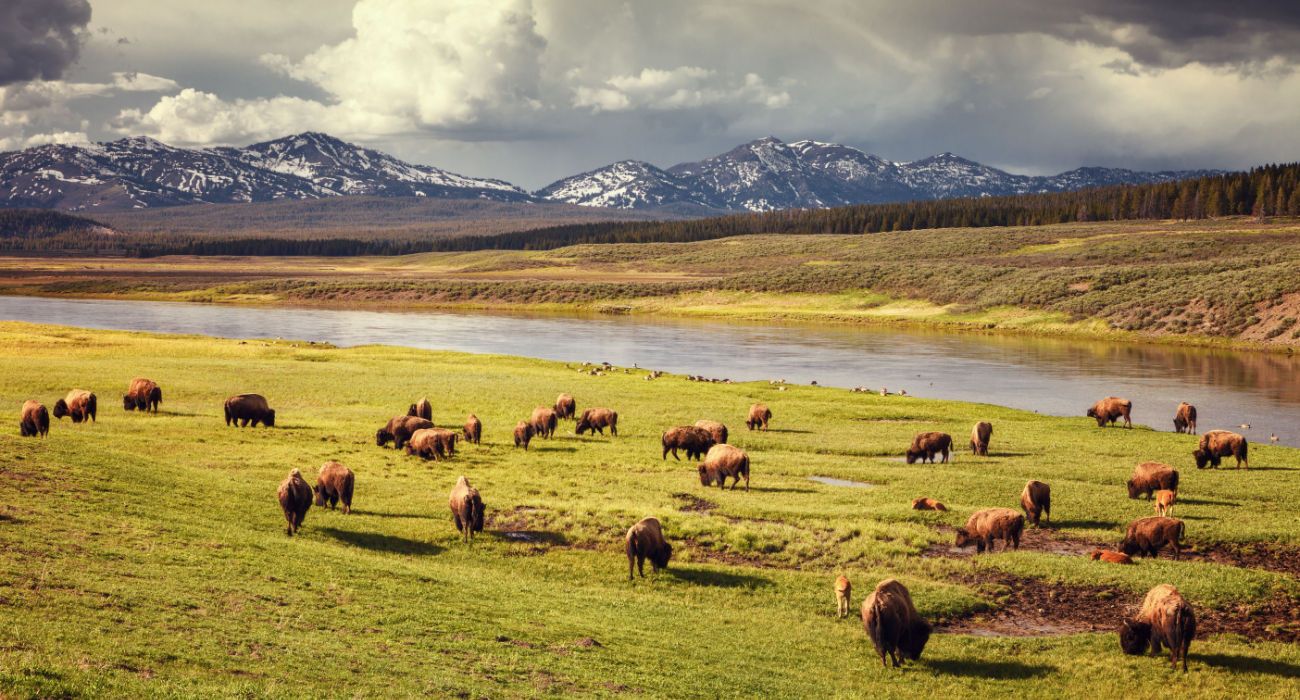Quick Links
Yellowstone is all about seeing the magnificent wildlife and the unparalleled geothermal activity of the region. Yellowstone is home to most of North America's most iconic wildlife (including grizzlies, wolves, bison, elk, cougars, and more). When visiting Yellowstone, it is important to note the seasons as the wildlife behavior changes significantly depending on the season. There are plenty of wildlife and photography tours of Yellowstone.
While wildlife may roam all through the park, there are a few valleys and hotspots that are particularly noted for their remarkable wildlife. One is Lamar Valley - known as the Serengeti of North America - and Hayden Valley. Hayden Valley is a large sub-alpine valley and is one of the best places to view the wildlife of Yellowstone.
Size & Origin Of Hayden Valley
Hayden Valley straddles the Yellowstone River between Yellowstone Falls and Yellowstone Lake. The floor of the valley is an ancient lake bed (Yellowstone Lake was once much bigger). The valley is centrally located in the national park and extends for around 7 miles (or 11 kilometers) from north to south and another 7 miles (or 11 kilometers) from east to west. A section of the Grand Loop Road of Yellowstone follows the eastern side of the valley.
- Size: 50 sq miles or 130 km2
The floor of Hayden Valley is full of fine-grained lake sediments from the prehistoric lake; these are overlaid for glacial till from the most recent glacial retreat around 13,000 years ago. The result is the valley being marshy with little encroachment of trees.
The valley was named in honor of Ferdinand Vandeveer Hayden, whose geological surveys led to the creation of Yellowstone National Park - America's (and the world's) first national park.
Hayden Valley - A Wildlife Hotspot Of Yellowstone National Park
The wildlife habitat that Hayden Valley supports is nothing short of outstanding. It is one of the best places to go on a safari in North America. Spot buffalo (bison), grizzly bears, coyotes, moose, bighorn sheep, white-tailed deer, pronghorn, wolves, elk, countless birds (including Canada geese and pelicans), and many smaller mammals.
Yellowstone is home to 67 different species of mammals and around 690 grizzly bears (in the Greater Yellowstone Ecosystem). Black bears are a common site, and gray wolves were reintroduced there in 1995 in a successful project. Other notable predators include wolverines, cougars, and lynxes.
Hayden Valley also has a number of geothermal features scattered around the valley, although these are not as impressive as their large geyser basins found elsewhere in the park (Yellowstone has over half of the world's active geysers and is hydrothermally unique). Notable geysers and hydrothermal attractions include Mud Volcano, Sulphur Caldron, Mud Geyser, and Black Dragon Caldron.
How To Access Hayden Valley
Understandably there are efforts to protect the wildlife of the valley and so the valley is closed to off-trail foot traffic. But there are two trails that enable hikers to explore the valley - the Hayden Valley trail and the Mary Mountain trail. Fishing is not permitted in the valley.
Hayden Valley Trail:
Runs along the eastern side of the valley from Lake to Canyon. This is a long hike, but it is possible to complete in one day (it's prudent to bring a headlamp in case the hike ends up being in the dark at the other end). Start at the Fishing Bridge Visitors Center and follow the Howard Eaton Fishing Bridge Canyon Trail north.
- Duration: Approx. 5-6.5 Hours
- Distance: 13.5 miles
Mary Mountain Trail:
Skirts the northern edge of the valley (running along Alum Creek to the Canyon-Lake road). Mary Mountain Trail is the most popular hiking trail in the Hayden Valley region and one of the best ways to explore the valley. On this trail, people can see the wildlife up close. It can be completed as an out-and-back hike or as a thorough hike with a shuttle service at the other end.
- Length: Over 21 Miles
- Season: Closed For Winter/Spring (March 10 to June 15)
Along the road, there are a number of roadside turnouts where people can pull over and gaze out into the valley and its wildlife. Some of the turnouts offer scenic overlooks with panoramic views of the valley. No one needs to go all the way to Africa to enjoy a wildlife safari!

